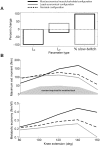Validated Predictions of Metabolic Energy Consumption for Submaximal Effort Movement
- PMID: 27248429
- PMCID: PMC4889063
- DOI: 10.1371/journal.pcbi.1004911
Validated Predictions of Metabolic Energy Consumption for Submaximal Effort Movement
Abstract
Physical performance emerges from complex interactions among many physiological systems that are largely driven by the metabolic energy demanded. Quantifying metabolic demand is an essential step for revealing the many mechanisms of physical performance decrement, but accurate predictive models do not exist. The goal of this study was to investigate if a recently developed model of muscle energetics and force could be extended to reproduce the kinematics, kinetics, and metabolic demand of submaximal effort movement. Upright dynamic knee extension against various levels of ergometer load was simulated. Task energetics were estimated by combining the model of muscle contraction with validated models of lower limb musculotendon paths and segment dynamics. A genetic algorithm was used to compute the muscle excitations that reproduced the movement with the lowest energetic cost, which was determined to be an appropriate criterion for this task. Model predictions of oxygen uptake rate (VO2) were well within experimental variability for the range over which the model parameters were confidently known. The model's accurate estimates of metabolic demand make it useful for assessing the likelihood and severity of physical performance decrement for a given task as well as investigating underlying physiologic mechanisms.
Conflict of interest statement
The authors are affiliated with L-3 Applied Technologies, Inc.
Figures







Similar articles
-
An EMG-driven model applied for predicting metabolic energy consumption during movement.J Electromyogr Kinesiol. 2011 Dec;21(6):1074-80. doi: 10.1016/j.jelekin.2011.07.003. Epub 2011 Aug 12. J Electromyogr Kinesiol. 2011. PMID: 21840224
-
A model of human muscle energy expenditure.Comput Methods Biomech Biomed Engin. 2003 Apr;6(2):99-111. doi: 10.1080/1025584031000091678. Comput Methods Biomech Biomed Engin. 2003. PMID: 12745424
-
Computation of the kinematics and the minimum peak joint moments of sit-to-stand movements.Biomed Eng Online. 2007 Jul 3;6:26. doi: 10.1186/1475-925X-6-26. Biomed Eng Online. 2007. PMID: 17608922 Free PMC article.
-
More is not always better: modeling the effects of elastic exoskeleton compliance on underlying ankle muscle-tendon dynamics.Bioinspir Biomim. 2014 Nov 24;9(4):046018. doi: 10.1088/1748-3182/9/4/046018. Bioinspir Biomim. 2014. PMID: 25417578
-
Optimization-based models of muscle coordination.Exerc Sport Sci Rev. 2002 Jan;30(1):32-8. doi: 10.1097/00003677-200201000-00007. Exerc Sport Sci Rev. 2002. PMID: 11800497 Free PMC article. Review.
Cited by
-
A century of exercise physiology: key concepts in muscle energetics.Eur J Appl Physiol. 2023 Jan;123(1):25-42. doi: 10.1007/s00421-022-05070-7. Epub 2022 Oct 22. Eur J Appl Physiol. 2023. PMID: 36271943 Free PMC article. Review.
-
Propulsion without penalty: greater soleus force with stiffer footwear does not necessarily increase estimated soleus metabolic cost across walking speeds.J Appl Physiol (1985). 2025 Aug 1;139(2):509-516. doi: 10.1152/japplphysiol.00045.2025. Epub 2025 Jul 18. J Appl Physiol (1985). 2025. PMID: 40679491 Free PMC article.
-
Using physiologically based models to predict in vivo skeletal muscle energetics.J Exp Biol. 2025 Apr 1;228(7):jeb249966. doi: 10.1242/jeb.249966. Epub 2025 Mar 31. J Exp Biol. 2025. PMID: 39960312 Free PMC article.
-
The legacy of A. V. Hill's Nobel Prize winning work on muscle energetics.J Physiol. 2022 Apr;600(7):1555-1578. doi: 10.1113/JP281556. Epub 2022 Feb 22. J Physiol. 2022. PMID: 35114037 Free PMC article.
-
Numerical instability of Hill-type muscle models.J R Soc Interface. 2023 Feb;20(199):20220430. doi: 10.1098/rsif.2022.0430. Epub 2023 Feb 1. J R Soc Interface. 2023. PMID: 36722069 Free PMC article. Review.
References
-
- Babcock MA, Johnson BD, Pegelow DF, Suman OE, Griffin D, Dempsey JA. Hypoxic effects on exercise-induced diaphragmatic fatigue in normal healthy humans. J Appl Physiol. 1995;78(1):82–92. Epub 1995/01/01. - PubMed
-
- Babcock MA, Pegelow DF, Taha BH, Dempsey JA. High frequency diaphragmatic fatigue detected with paired stimuli in humans. Med Sci Sports Exerc. 1998;30(4):506–11. Epub 1998/05/05. - PubMed
-
- Gonzalez-Alonso J, Mora-Rodriguez R, Below PR, Coyle EF. Dehydration reduces cardiac output and increases systemic and cutaneous vascular resistance during exercise. J Appl Physiol. 1995;79(5):1487–96. Epub 1995/11/01. - PubMed
-
- Romer LM, Haverkamp HC, Amann M, Lovering AT, Pegelow DF, Dempsey JA. Effect of acute severe hypoxia on peripheral fatigue and endurance capacity in healthy humans. Am J Physiol Regul Integr Comp Physiol. 2007;292(1):R598–R606. - PubMed
Publication types
MeSH terms
LinkOut - more resources
Full Text Sources
Other Literature Sources

